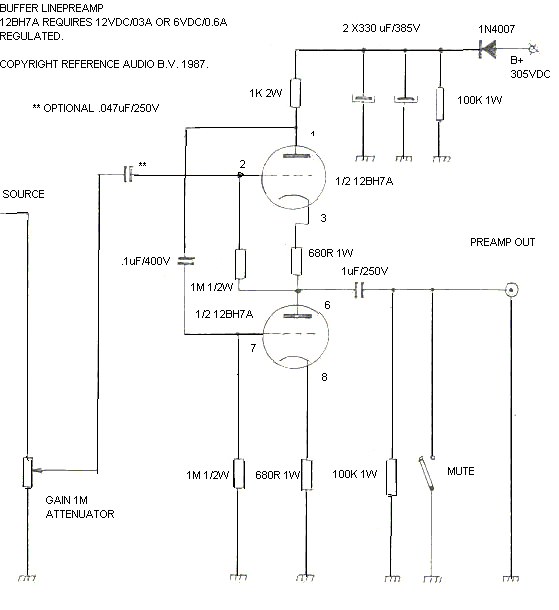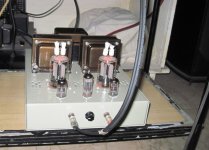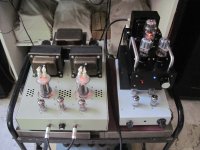I wonder where this stands in terms of audibility? Separating channels from each other has, in my limited experience, made an audible improvement. I have, for example two RH84s Rev2. One was made with high quality parts as a regular stereo amp, and the other made from junk box parts as a throw away and has two full power supplies. It is two mono blocks in one box. The junk box one sounds better. This is not scientific of course, but it seems that most people would agree that mono block designs are better sounding.
Last edited:
My home SET amps use two different power supply rails. Tube rectified and choke input filtered. One main benefit here is the lack of a huge resistor needed to drop the voltage.
Schematic: https://s23.postimg.org/qg9u7g0kb/6_P45_S_4.png
Splitting the power supply has its sonic subjective benefits IMHO, but the best for you is to try yourself. It will also cost and weight more.
Although I'd bet on a single supply with higher quality parts than two split supplies with poor parts. The choice is yours.
Schematic: https://s23.postimg.org/qg9u7g0kb/6_P45_S_4.png
Splitting the power supply has its sonic subjective benefits IMHO, but the best for you is to try yourself. It will also cost and weight more.
Although I'd bet on a single supply with higher quality parts than two split supplies with poor parts. The choice is yours.
Last edited:
"High quality parts" do not necessarily make a better amp (apart from OPTs).
"Sounds better" is a subjective matter; largely a matter of taste.
It is obvious that coupling between channels will degrade the stereo image, yet FM radio and vinyl are capable of good sound in spite of relatively poor channel separation; some folk even prefer them to CD (which has much better channel separation).
"Sounds better" is a subjective matter; largely a matter of taste.
It is obvious that coupling between channels will degrade the stereo image, yet FM radio and vinyl are capable of good sound in spite of relatively poor channel separation; some folk even prefer them to CD (which has much better channel separation).
Not necessarily, but they go together hand to hand with proper device design to achieve high-fidelity sound. What makes a high quality component? The one that gives more (subjective) sonic benefits (and probably measurable ones) than negative effects. Not necessarily cost related. My 2 cents.
Separating channels from each other has, in my limited experience, made an audible improvement.
i saw one guy used two marantz 7 pre-amps, on one he used as left channel only, and the other as right channel only....
Frank used 1n4007's to split the common psu into left or right channels,
i used this tack too, but i can not say it really helped except to say it made
sense to me...channel separation i would say...
But, does the left and right channel interaction only effect channel separation?
I would think that there would also be IM products and that these would be more important (in a negative way) to sound quality?
I've wondered the same thing about PSUs where the driver tube derives the voltage via an RC network from the driver tubes.
I've seen one design where drivers and input stages derived their voltage via RC networks straight from B+. I would think that is worth investigating, at least for Push Pull class A?
Lars
I would think that there would also be IM products and that these would be more important (in a negative way) to sound quality?
I've wondered the same thing about PSUs where the driver tube derives the voltage via an RC network from the driver tubes.
I've seen one design where drivers and input stages derived their voltage via RC networks straight from B+. I would think that is worth investigating, at least for Push Pull class A?
Lars
But, does the left and right channel interaction only effect channel separation?
I would think that there would also be IM products and that these would be more important (in a negative way) to sound quality?
the reasoning for that i gathered was that in a common psu
the amp channels can talk to each other, thus they total separation,
i do not know how effective, i never tried it...
I've wondered the same thing about PSUs where the driver tube derives the voltage via an RC network from the driver tubes.
I've seen one design where drivers and input stages derived their voltage via RC networks straight from B+. I would think that is worth investigating, at least for Push Pull class A?
Lars
that is typical in any tube amp.
i did a 5894 SET wherein the output tubes are fed from its own psu,
the voltage amp and the cathode followers are fed from its own power supply on a separate power traffo winding and at a bit higher at 400+ volts, whereas the output tubes were fed from its own psu at around 350 volts.....
Attachments
If the diodes are forward biased then they achieve nothing. If they are not then either they are acting as main rectifiers, or they will introduce distortion into any interchannel crosstalk which is present. So better off without them. I know there is a myth that diodes can pass DC while blocking AC but this is a myth i.e. not true.AJT said:Frank used 1n4007's to split the common psu into left or right channels,
I built a preamp based on the svp.
I already had a working fvp with super reg.
I rebuilt it with 2 kandk shunt regs with ccs and a larger output transformer. A big enough transformer from an intergrated 15w push pull amplifier.
The sound improved greatly. But i do not know what was the greater contributer. I then transitioned to the svp for further improvement.
I am now building the same preamp for a friend except It has 4 kandk shunt regs. 2 per channel. 1 per stage. Plus it will have dual power supplies and i will be using 4 heater supplies from kandk. (Using 5687s in linestage) Reducing load on the power transformers.
I do not know if it will be much improved , but i am having fun doing it. And they both have mostly the same parts . So i should be able to AB it.
We have plans to build power amps in the nearish future. We are going to try and carry the same level of stage seperation using shunts transformer and ccs.
I will say though if you do consider modifying existing amps with this sort of concept. Be careful to check if you can supply enough power to the shunts, and not run out or low. Its best to use a new design and scale power accordingly.
I already had a working fvp with super reg.
I rebuilt it with 2 kandk shunt regs with ccs and a larger output transformer. A big enough transformer from an intergrated 15w push pull amplifier.
The sound improved greatly. But i do not know what was the greater contributer. I then transitioned to the svp for further improvement.
I am now building the same preamp for a friend except It has 4 kandk shunt regs. 2 per channel. 1 per stage. Plus it will have dual power supplies and i will be using 4 heater supplies from kandk. (Using 5687s in linestage) Reducing load on the power transformers.
I do not know if it will be much improved , but i am having fun doing it. And they both have mostly the same parts . So i should be able to AB it.
We have plans to build power amps in the nearish future. We are going to try and carry the same level of stage seperation using shunts transformer and ccs.
I will say though if you do consider modifying existing amps with this sort of concept. Be careful to check if you can supply enough power to the shunts, and not run out or low. Its best to use a new design and scale power accordingly.
If the diodes are forward biased then they achieve nothing. If they are not then either they are acting as main rectifiers, or they will introduce distortion into any interchannel crosstalk which is present. So better off without them. I know there is a myth that diodes can pass DC while blocking AC but this is a myth i.e. not true.
i will not contest this....but hey diodes are so cheap i buy them by the hundreds...even if i need just a pair or two...you are right about the myth....
here is what frank said....
"What is the purpose of the 1N4007?"
I knew you'd ask about that.
What it does is preventing the PSU caps in the preamp chassis to discharge into the PSU chassis proper.
Basically this prevents arcing when connecting the two chassis together.
In view of the fact that video connectors multiple poles are used to connect both units over an umbillical cord, see it as a safety measure.
Doing away with it can cause serious damage to the connectors and arc-overs are definitely real with this kind of voltages and caps.
Cheers,

i first saw this done in a fedgrove designed line amp....http://www.diyaudio.com/forums/tubes-valves/12042-franks-ultimate-tube-preamp.html
You are absolutely right, I, like most others, proceeded straight on what the OP asked, thinking the "article" cited was most probably about the same thing, maybe in other words.It seems that everyone is replying to the title of the thread and not the content. The paper cited in the OP is near nonsense. How about some proof of audibility?
Curious by your post I actually clicked and read: what a load of C R A P ..... literally, since he recommends reading his "Audio Works" in the potty !!!
HIs words, not mine.
Absolutely stoopid and bad taste suggestion, even beyond the Acoustic realm, since sipping high quality wine or champagne and smoking high quality tobacco is a pleasure of the senses, not to be destroyed by mixing them with disgusting odors .SUGGESTION: DOWNLOAD THIS BOOK, AND READ IT ON THE POTTY WHILE YOU ARE SIPPING CUVEE DOM PERIGNON ’54, WHILE PUFFING ON A ROMEO Y JULLIETTE CUBAN CIGAR.
That alone disqualifies him and I am not the least interested in what other idead and opinions he might have on *anything* else.
hey Tizman, i subscribe to your idea of separate supplies,
in fact the ASL 1006 i repaired used such a tact.....http://www.diyaudio.com/forums/tube...-antique-sounds-1006-845-set.html#post5015232
in fact the ASL 1006 i repaired used such a tact.....http://www.diyaudio.com/forums/tube...-antique-sounds-1006-845-set.html#post5015232
I have started working on another RH84 Rev2 that will have one power supply for each power tube/channel that is somewhat bigger than required, and one power supply for the preamp/driver tubes that is much bigger than required. All of these will be on one chassis. It should be interesting to see how that turns out. To me, it just makes sense that keeping them separate would be a good thing, just as keeping the channels separate is.
In Dr. Gizmo's defense, there was a lot in that article that is sound advice for amp builders. Also, there is a lot of his typical irreverent humor. Which is mostly why I read his stuff. There isn't a whole lot of comedy in this hobby. Nelson Pass, while obviously completely different, is also refreshingly funny.
In Dr. Gizmo's defense, there was a lot in that article that is sound advice for amp builders. Also, there is a lot of his typical irreverent humor. Which is mostly why I read his stuff. There isn't a whole lot of comedy in this hobby. Nelson Pass, while obviously completely different, is also refreshingly funny.
- Status
- This old topic is closed. If you want to reopen this topic, contact a moderator using the "Report Post" button.
- Home
- Amplifiers
- Tubes / Valves
- Separate power supplies for power and pre/driver tubes

